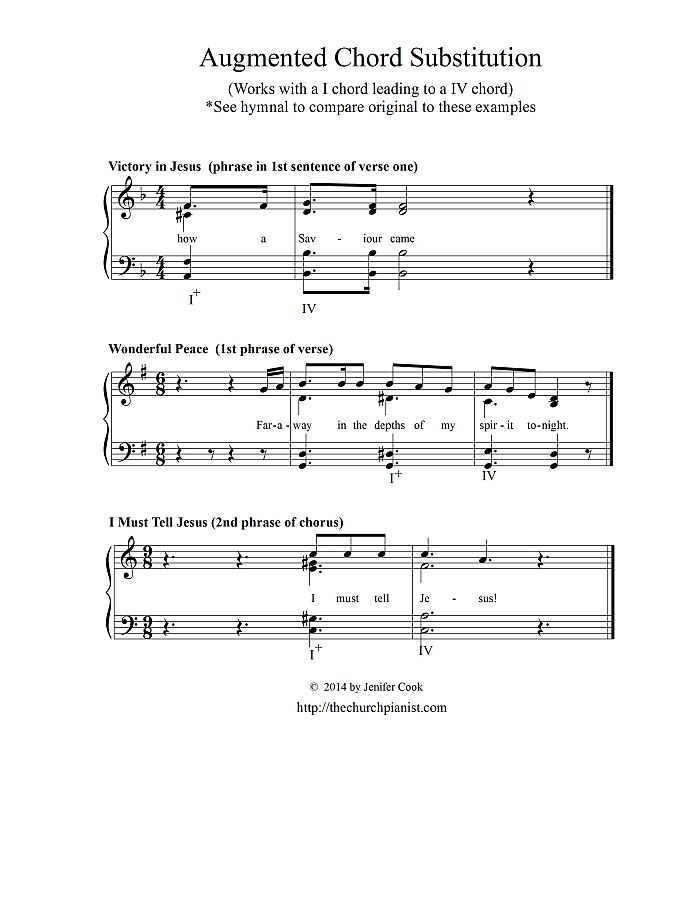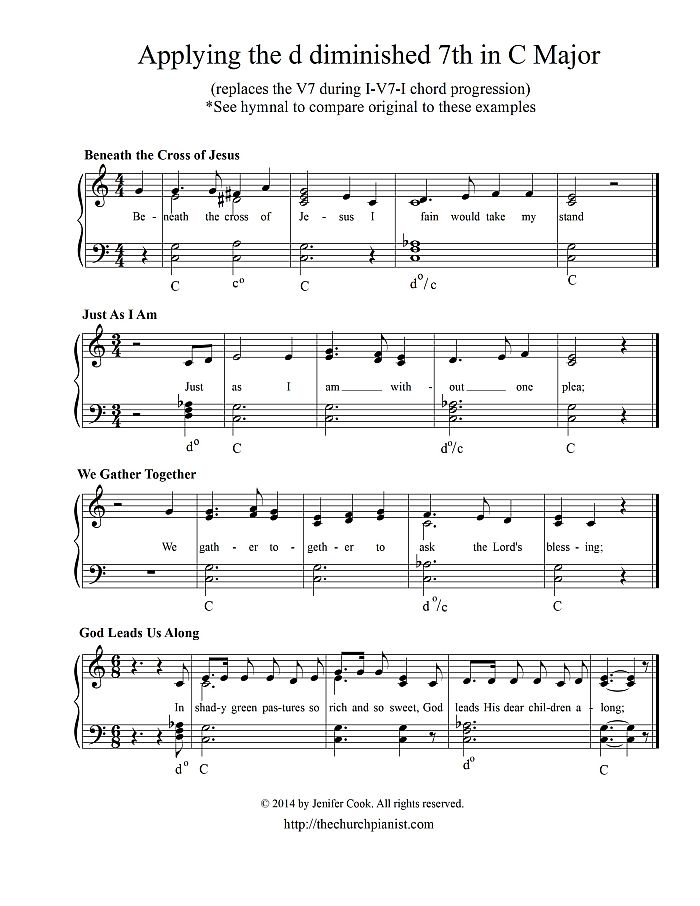Color Up Your Hymnplaying with this Color Chord Combo!
Friday, September 9th, 2022Warning! Pause and reverse as needed for this short tutorial!
| The Church Pianist |
| A help ministry for church pianists all over the world! |
This is a clarification for those who have purchased the “Diatonic Chord Substitution Lesson One” tutorial. But…anyone can glean from this post!
I recently received an email with this question…
“You said if there are four different notes…then it is a 7 chord.” (She’s referring to analyzing chords from the hymnal.)
She goes on to say, “…however, on your example of “It is Well” (page four of the handout)…on the word “like”, there are four different notes and I don’t think it’s a C7 chord. It looks more like a G¹¹ chord or something…but you say to play a C chord for that whole measure.” Click on image for enlarged view.
Excellent question!
So…here’s the answer…
When coming across this situation where the chord can’t be placed in consecutive thirds…you are more than likely dealing with “passing tones”. The passing tones are found in the right hand part for this particular example.
Passing tones are secondary notes you have to pass through to move from one note to the next. Passing tones are not meant to be factored in… to the underlying chordal structure of a measure.
So…look at the word “like” in the picture above. The right hand notes are “D & F”
Now…step back and look at the overall note ingredients within that measure. The majority of the notes favor what chord? Yes! The C chord. That’s why I played within a C chord frame for that measure as you’ll see in the next picture below. (I should have made the left hand note “E” a half note.)
Passing tones to music are like joints to the human body. Our joints support movement as the passing tones do to music. Passing tones are like the accessories/dress-up to the overall melody of a song.
Thanks to one of my readers for a great question!
Just published my first tutorial on Diatonic Chord Substitution Lesson One!
Wow! WHAT a time I had creating this tutorial!
I focused on making it as easy to understand as possible!
The seventeen minute companion video is loaded with visuals!
The first mini lesson on Diatonic Chord Substitution is almost complete!
I had SO much fun creating this short mini lesson that involves seven pages in addition to answer key pages and at least a 17 minute video companion chock full of visuals!
I hope to publish the entire project by this Friday. Watch short commercial below with few bloopers!
I’ve provided the recent “broadcast” from facebook. *See written article below for essential information that goes with the video.
On a lighter note….”Don’t you just LOVE my piano?! It’s one of a kind…..treble is at the bottom…bass at the top! (Just kidding) *The dilemma was a front facing camera.
Jenifer Cook is going live on Facebook this Thursday at 8 pm EST. (November 10, 2016)
Ever notice how a lot of Christmas hymns have frequent
accidentals…the makings for awkward hand movements…
Hear Jenifer’s suggestions in dealing with accidental passages. She’ll be showing her note changes on the handouts listed below…feel free to either print them or have them on a screen for viewing purposes for tonight’s session. So much to share in a short time span!!
Copy and paste this link in the URL field at the top of your browser page: https://www.facebook.com/Jenifer-Cook-602815303135832/?fref=ts
Print the following FREE music example pages for tonight’s “going live on facebook” session with Jenifer
O Little Town of Bethlehem (verse only)
O Little Town of Bethlehem (verse only w/ application)
Have a pencil handy too! 
Explanation of the following visual:
When progressing from a I to IV chord…raise the 5th note of the I chord (G) to (G#) making it an augmented I chord which strongly leads into a IV chord.

“Diminish” (verb) to make smaller vs. “Augment” (verb) to make larger
A diminished chord is a minor chord with a lowered 5th
Example: C Eb Gb Or expressed as: C°
Suggested role of the diminished chord: creates suspense
An augmented chord is a major chord with a raised 5th
Example: C E G# Or expressed as: C+
Suggested role of the augmented chord: generates amazement; surprise; anticipation
The diminished or augmented chord is not found within the scale. The pianist must alter the notes of a chord to create either one of these chords.
~ ~ ~ ~ ~ ~ ~ ~ ~ ~ ~ ~ ~ ~ ~ ~ ~ ~ ~ ~ ~ ~ ~ ~ ~ ~ ~ ~
Visual examples of the d diminished in the key of C Major
d diminished = D F A flat
*diminished 7ths are more common; create fuller sound
d diminished 7th = D F A flat C
The symbol ° after the chord letter name… represents diminished chord
The / separates the diminished chord from the bass note (the slash is used when the bass note is NOT the root note of the diminished chord.)
Click here to download visual example for application of the d diminished 7th chord.

Special note: Yes, I should have included a “slash” indicating the “C” as the bass note for the last example on the word “leads”. Hope you caught it! 🙂
